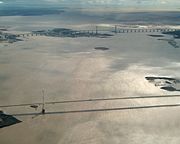
Severn crossing
Did you know...
This Wikipedia selection is available offline from SOS Children for distribution in the developing world. Before you decide about sponsoring a child, why not learn about different sponsorship charities first?
Severn crossing is a term used to refer to the two motorway crossings over the River Severn estuary between England and Wales. The two crossings are:
- The Severn Bridge ( Welsh: Pont Hafren)
- The Second Severn Crossing (Welsh: Ail Groesfan Hafren)
The first motorway suspension bridge was inaugurated on 8 September 1966, and the newer cable-stayed bridge, a few miles to the south, was inaugurated on 5 June 1996. The Second Severn Crossing marks the upper limit of the Severn estuary.
The two Severn crossings are regarded as the main crossing points from England into South Wales. Prior to 1966 road traffic between the southern counties of Wales and the southern counties of England – including London – either had to travel via Gloucester or take the Aust Ferry, which ran roughly along the line of the Severn Bridge, from Old Passage near Aust to Beachley. The ferry ramps at Old Passage and Beachley are still visible.
Tolls are collected on both crossings from vehicles travelling in a westward direction only. As of January 2008, the toll for a car is £5.30.
Railway crossing
The Severn Tunnel, carrying mainline trains under the Severn, follows a very similar route to the Second Severn Crossing. From 1879 until its collapse in 1960 the Severn Railway Bridge also carried trains across the Severn from Sharpness to Lydney.
The future
The proposed Severn Barrage will constitute a third crossing if it is ever built. It is generally presumed that it would carry a road crossing. Until recently, a rail link over it had been ruled out because the barrage would contain a huge set of shipping locks that the rails would need to traverse. However, it has been suggested that a rail bridge could carry smaller, modern trains over the locks, so a rail link is possible.



